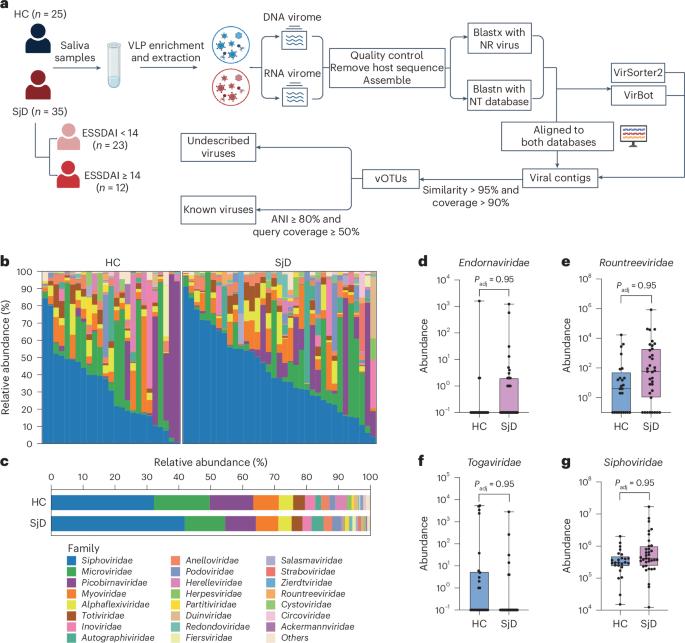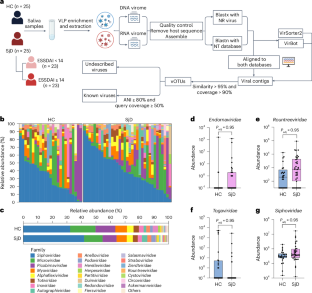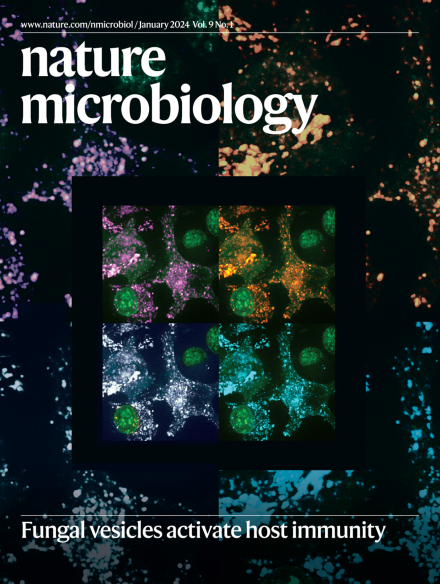Vientovirus capsid protein mimics autoantigens and contributes to autoimmunity in Sjögren’s disease
IF 19.4
1区 生物学
Q1 MICROBIOLOGY
引用次数: 0
Abstract
Viral infections are implicated in the pathogenesis of autoimmune diseases, including Sjögren’s disease (SjD), but the mechanisms linking viral antigens to disease development remain poorly understood. To address this, we conducted shotgun metagenomic sequencing of saliva samples from 35 patients with SjD and 25 healthy controls. The salivary virome of the patients with SjD, particularly those with high disease activity, had an expansion of Siphoviridae bacteriophages and increased eukaryotic viral sequences, including Vientovirus. This virus was associated with lacrimal gland dysfunction and elevated anti-SSA/Ro52 autoantibody levels. Alignment analysis and cross-blocking assay identified molecular mimicry between the Vientovirus capsid protein and the autoantigen SSA/Ro52. Mice immunized with a Vientovirus capsid peptide developed anti-SSA/Ro52 antibodies and showed immunological features resembling those of patients with SjD. These findings highlight distinct virome profiles in SjD and provide mechanistic evidence supporting the role of Vientovirus in triggering autoimmunity through molecular mimicry. Salivary virome profiling revealed distinct virome profiles in Sjögren’s disease and a role for Vientovirus in triggering autoimmunity through molecular mimicry.


病毒衣壳蛋白模拟自身抗原,促进Sjögren疾病的自身免疫
病毒感染与自身免疫性疾病的发病机制有关,包括Sjögren病(SjD),但将病毒抗原与疾病发展联系起来的机制仍然知之甚少。为了解决这个问题,我们对35名SjD患者和25名健康对照者的唾液样本进行了鸟枪宏基因组测序。SjD患者的唾液病毒组,特别是那些疾病活动性高的患者,唾液病毒科噬菌体扩增,真核病毒序列增加,包括维也纳病毒。该病毒与泪腺功能障碍和抗ssa /Ro52自身抗体水平升高有关。比对分析和交叉阻断实验表明,该病毒衣壳蛋白与自身抗原SSA/Ro52具有分子相似性。用Vientovirus衣壳肽免疫小鼠可产生抗ssa /Ro52抗体,并表现出与SjD患者相似的免疫特征。这些发现突出了SjD中不同的病毒组特征,并提供了支持维也纳病毒通过分子模仿触发自身免疫作用的机制证据。
本文章由计算机程序翻译,如有差异,请以英文原文为准。
求助全文
约1分钟内获得全文
求助全文
来源期刊

Nature Microbiology
Immunology and Microbiology-Microbiology
CiteScore
44.40
自引率
1.10%
发文量
226
期刊介绍:
Nature Microbiology aims to cover a comprehensive range of topics related to microorganisms. This includes:
Evolution: The journal is interested in exploring the evolutionary aspects of microorganisms. This may include research on their genetic diversity, adaptation, and speciation over time.
Physiology and cell biology: Nature Microbiology seeks to understand the functions and characteristics of microorganisms at the cellular and physiological levels. This may involve studying their metabolism, growth patterns, and cellular processes.
Interactions: The journal focuses on the interactions microorganisms have with each other, as well as their interactions with hosts or the environment. This encompasses investigations into microbial communities, symbiotic relationships, and microbial responses to different environments.
Societal significance: Nature Microbiology recognizes the societal impact of microorganisms and welcomes studies that explore their practical applications. This may include research on microbial diseases, biotechnology, or environmental remediation.
In summary, Nature Microbiology is interested in research related to the evolution, physiology and cell biology of microorganisms, their interactions, and their societal relevance.
 求助内容:
求助内容: 应助结果提醒方式:
应助结果提醒方式:


